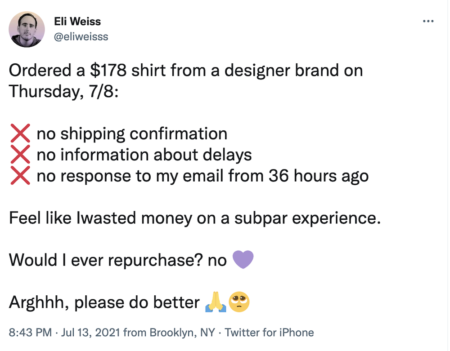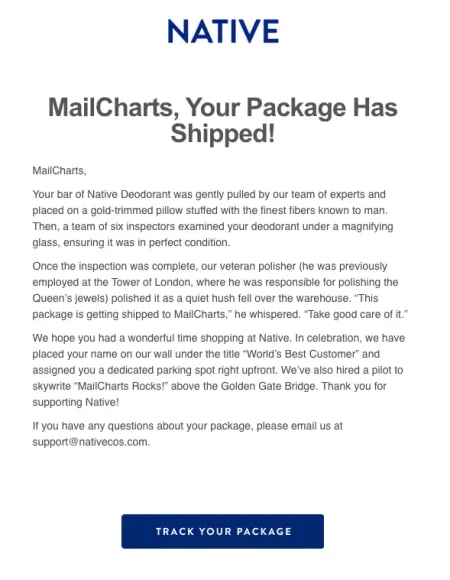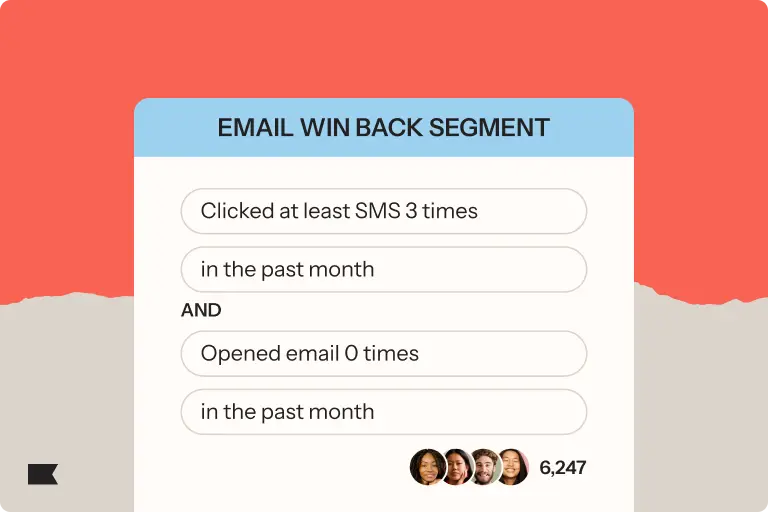10 ways to make your shipping confirmation email more than a transactional notification

If you think shipping confirmation emails are simply transactional updates that customers delete or ignore, think again.
A renewed focus on customer retention has made the post-purchase experience crucial to a business’s long-term success. As a result, leading ecommerce brands are paying close attention to every touchpoint after the initial purchase.
One of them is the shipping confirmation email.
On the surface, the shipping confirmation email might seem like nothing more than a simple notification. But dig a little deeper, and you’ll find that the shipping email actually has the potential to generate revenue and build your brand—if you know how to do it right.
To help you crack the code of an effective shipping confirmation email, we’ve put together a guide that discusses several benefits, best practices, and examples from well-known ecommerce brands. Buckle up.
What is a shipping confirmation email?
Shipping confirmation emails are transactional emails sent to inform customers that their order has been processed and shipped. They typically contain product info, order and delivery date, delivery address, shipping method, tracking code, and payment details.
What makes transactional emails different from marketing emails is that they are trigger-based emails geared at relaying essential information to the customer rather than generating sales.
Still, shipping emails are an important component of any email marketing strategy.
“Transactional emails in ecommerce are literally to match a transaction (a purchase) in lieu of a physical receipt and to provide information to bridge the gap of not bringing home a product with you,” explains Kristina Lopienski, director of content marketing, ShipBob.
At their core, transactional emails “exist as a record but also to meet customer expectations, as consumers want to make sure their purchase went through as planned and then receive details on when it will arrive,” Lopienski adds. “It’s a comfort zone thing, where you check your inbox to make sure it’s there and can refer back to it for delivery tracking when needed.”
It’s a comfort zone thing, where you check your inbox to make sure it’s there and can refer back to it for delivery tracking when needed.
Another key distinction between marketing and transactional emails is the fact that transactional emails are not tied to whether or not someone has subscribed or otherwise opted in to receive emails from you. In other words, if someone makes a purchase, they receive an email, whether they are a subscriber or not.
For this reason, you must be extremely careful about marketing or selling to shoppers through transactional emails, or else you risk violating the compliance rules and regulations such as the CAN-SPAM Act.
The best way to do this is to follow the 80/20 rule, where at least 80% of your shipping confirmation email is transactional content and, at most, 20% is marketing content. This gives you the flexibility to include call-outs for promotional opportunities, while also ensuring you remain compliant with spam laws.
Follow the 80/20 rule where at least 80% of your shipping confirmation email is transactional content and, at most, 20% is marketing content.
Why are shipping confirmation emails important?
Transactional emails may not seem like the most exciting message in your arsenal of customer communications. Still, clever marketers know every email is an opportunity—especially when these types of emails receive open rates as high as 85% (compare this to the 20-25% average open rate of marketing emails).
At this point, a shipping confirmation email is way beyond “nice to have.” Consumers expect to receive a notification with all their shipping details. If they don’t, you’ll have a dissatisfied customer on your hands—and you might even lose them forever.

The truth is shipping confirmation emails don’t always get the attention they deserve from marketers. But if you include a few basic components and add a splash of creativity, shipping emails can have a positive impact on your business.
“Transactional emails are some of the most important and most opened emails for an ecommerce brand, yet they typically receive very little love in implementation,” points out Marc van Bree, director of partner marketing and events, ShipStation. “Every touchpoint with your customer is an opportunity to showcase your brand, so brands should not settle. They should really make these emails their own.”
Every touchpoint with your customer is an opportunity to showcase your brand, so brands should not settle. They should really make these emails their own.
Here are some of the benefits of investing time and energy into creating effective shipping confirmation emails:
1. They improve the post-purchase experience and increase LTV
Marketing doesn’t stop the moment customers make a purchase. Smart marketers know that’s just the beginning.
Creating an engaging post-purchase experience is part of what keeps customers coming back. And a shipping confirmation email is a crucial component of the post-purchase experience puzzle.
“Transactional emails are viewed 3x more than marketing emails on average,” says Noah Rahimzadeh, director of partnerships, Malomo. “If brands are not ensuring their transactional messaging is on brand and personalized, they are missing a huge opportunity to drive retention and LTV.”
2. They build customer loyalty
When customers buy something from your brand, they expect to be informed of the details. Bonus points if you answer all their questions even before they ask.
“Transactional emails are table stakes in ecommerce today—not only in setting customer expectations but as a way to protect and grow a brand’s bottom line,” says Joyce Lee, sr. director, platform and ecosystem partnerships, Narvar.
Transactional emails are table stakes in ecommerce today—not only in setting customer expectations but as a way to protect and grow a brand’s bottom line.
With open rates on average above 70%, transactional emails are proof that customers crave order-related communication, Lee points out. And that means “it’s paramount for brands to keep their customers in lockstep with their orders as a way to consistently set expectations and reduce ‘Where is my order?’ calls—leading to a positive customer experience and higher customer lifetime value.”
Lee adds that at Narvar, brands that send transactional emails see an average of 50% fewer ‘Where is my order?’ calls to their call centers. As Lee puts it, “an engaged customer becomes your best customer, and their chances of repurchasing become higher as a result of that engaged experience.”
3. They help you establish a unique voice for your brand
Successful brands have one thing in common—consistency across every touchpoint. You can’t sell a story that customers are at the core of everything you do and then ignore your brand voice important touchpoints such as shipping confirmation emails.
“Marketers need to be utilizing these interactions with customers while they have them engaged,” says Winnie Ng, partner marketing manager, AfterShip. “The No. 1 priority is ensuring that the entire post-purchase experience is branded.”
“Sending customers to a carrier tracking page breaks the connection you’re trying to build with them,” Ng continues. “This is also a great opportunity to include additional product recommendations and even share educational content on how to use the products they are about to receive.”
How to set up a shipping confirmation email
If you’re using Klaviyo, you can set up a shipping confirmation email in 2 ways:
Create a post-purchase flow
In Klaviyo, transactional emails are delivered through flows because they are triggered by an action a customer takes. But you can combine a transactional email with other marketing emails in a flow.
For example, you may have a post-purchase flow that includes both an order confirmation email and a shipping confirmation email, while the subsequent marketing emails are aimed at generating product reviews and cross-selling related products.
Leverage Klaviyo’s pre-built Shopify transactional email templates
If you’re using Shopify for your ecommerce store, you can use many default email templates for automated notifications, including shipping notifications.
But while these templates are functional, there is no built-in template editor in Shopify that you can use to customize and style these emails.
With Klaviyo, you can fully customize your Shopify notification templates with a distinct layout and style, then export and paste them into Shopify. Learn more about how email marketing plug-ins for Shopify can help you run your business.

10 ways to take your shipping confirmation emails to the next level
When crafting a shipping confirmation email, marketers can play around and experiment with different elements. Here are 10 best practices to keep in mind when designing a shipping confirmation email.
1. Include a tracking link
A tracking link is the most important component of a shipping confirmation email. It allows customers to see their order status in real time and gives them a sense of control and certainty.
The purpose of adding a tracking link to your shipping email is twofold: First, it gives customers peace of mind. And second, allowing customers to track their new purchases as they make their way to their doorstep boosts customer satisfaction and morale.
Additionally, besides just including the tracking link in the body of the email, you can add it to the subject line so it’s easy to locate in someone’s inbox and recognize it as a shipping confirmation email.
Sustainable footwear brand Alohas uses its shipping confirmation email to notify customers that their order is on its way, giving them a tracking number and a link they can click to see the status of the shipment. The email also includes product details and the customer’s billing and shipping address.

2. Include product details
There’s a certain sense of relief when you receive a shipping confirmation email and see that the right product is on its way to your address. That’s exactly why you need to include product details in your shipping email.
Adding an image of the product a customer bought, plus product specifications and purchase information, makes it easy for them to access the shipping confirmation email and feel confident that everything is accurate.
Consider adding the following details:
- Name(s) of the item(s)
- Description (size, color, quantity, etc.)
- Shipping method (USPS, UPS, FedEx, etc.)
- Delivery and billing address
- Order number or ID
- Order date
- Billing summary and payment details
- Estimated arrival time
Vuori, an athletic clothing and activewear brand, notifies customers about their recent purchases by including an image of what they bought and adding product information such as color, size, and price.

Plus, information about returns, stores, and frequently asked questions are just a click away, creating a premium customer experience.
3. Provide customer support resources
Struggling to access support when something goes wrong is one of the most frustrating feelings for a customer.
Since the main goal of the shipping confirmation email is to notify customers that their order is on its way, you should also include an easy method for contacting your support team if the customer has any questions.
You may also want to anticipate some of your customers’ questions and preemptively include links to FAQs, return policies, or other helpful pages. Letting customers know you’re there before they even ask helps increase customer confidence, loyalty, and trust.
4. Highlight the estimated delivery date
Living in a world of instant gratification makes waiting hard.
To ease the anxiety, include an estimated delivery date in your shipping confirmation email—this way, your customers know when to expect their order to arrive.
Adding an estimated delivery date also creates a sense of anticipation and excitement.
5. Take the opportunity to cross-sell
Once a customer has placed their order, you may want to suggest related items that go well with what they just bought. Suggesting complementary products post-purchase is optional, but it can be an effective way to encourage a second purchase.
To do this successfully, make the email as personal as possible. Try suggesting products from the same collection, or curating a set of products that would complement the particular item a customer just bought.
You might also consider adding product recommendations in a shopping confirmation email instead of an order confirmation email. The reason is simple—by the time a shipping confirmation goes out, the order information has already been processed, and the product recommendations take the shipped order details into account.
Bedding brand Buffy uses their shipping confirmation email to offer customers complementary products they might be interested in. The email design is clean and simple, highlighting the purchased product but also including a recommendation section.

6. Add valuable content resources
Transactional emails don’t have to be all business. There are plenty of ways to provide extra value to customers through your shipping confirmation email.
Consider what other content you can include in your transactional emails to enhance the customer experience. Here are a few ideas:
- Referral program call-outs
- Instagram feeds and social proof
- Membership or subscription offers
- Blog content
- Surveys, reviews, or feedback requests
- Helpful guides or next steps
Customer education is at the heart of everything The Sill does. The online houseplant retailer is dedicated to helping customers take care of their plants and offers extensive resources to achieve that goal.
Consider this shipping confirmation email. The Sill is aware that every plant is specific, so they include a downloadable PDF with tailored care instructions at the same time, they notify the customer that their order is on its way.

7. Align the copy and design to your brand
A shipping confirmation email is one more touchpoint on the customer journey. Branded design and copy help make yours feel like an integral part of your customer communication efforts.
Try going beyond the basic shipping confirmation email template by aligning the copy and design of your shipping confirmation emails to your brand.
If your brand has a reputation for a witty, irreverent voice and tone, for example, reflect that in your shipping confirmation email copy. If your brand takes a distinctive, minimalist approach to design, incorporate the same approach in your shipping email.
Aura Bora does this well. The renowned sparkling water brand has eye-catching branding with specific colors, designs, typography, and copy. All these elements are woven into its shipping confirmation email, making it memorable.

8. Highlight your loyalty or referral program
If you have a loyalty or referral program, the shipping confirmation email is a great opportunity to remind customers about it. Building your loyalty program takes time, which is why you should utilize as many touchpoints as possible to promote it and entice customers to take part.
Try using your shipping confirmation email to showcase how many points the customer has earned in your loyalty program, or encourage them to join a loyalty program or refer friends if they haven’t yet.
9. Communicate delays and disruptions
Setting the right expectations is the key to building a solid customer relationship. Any time a shipping or fulfillment issue might affect the customer experience, ensure you use your transactional emails to communicate the delay, so they know what to expect.
“People usually understand that carriers make mistakes, so when brands acknowledge that with transparency, consumers are less likely to get upset and reach out to the brand—or worse, tell their family and friends how terrible customer support was,” says Yaw Aning, co-founder and CEO of Malomo.
“Brands can put a message in their shipping confirmation email acknowledging the delays and issues that could arise with the package while using their unique tone and voice,” Aning continues.
This is exactly what Celtic Serenity did. They included a shipping delay announcement in their shipping confirmation email when they experienced shipping delays during the busy holiday season. In this shipping confirmation email, they reassure the customer their order is on its way—and offer an alternative gift idea in case it doesn’t arrive in time for the holiday.

10. Include information about returns and exchanges
The more upfront you are with your customers about their orders, the more they trust your brand. Including information about returns and exchanges is crucial in setting expectations.
Customers are often looking for information regarding product returns, so instead of forcing them to go down the rabbit hole and search through your online store, include returns information in the shipping confirmation email.
By doing this, you gain the trust of your customers, and they get the information they need. It’s a win-win.
9 shipping confirmation email examples—and why they work
A shipping confirmation email is one of the first steps to creating a positive post-purchase customer experience. If you need inspiration for an effective shipping email, take a look at the following ideas from 9 innovative brands:
1. HABIT
Skincare startup Habit is developing the next generation of sunscreen products, focusing on functional, fun formats and innovative formulas. The brand uses this shipping confirmation email to share important information with the customer, such as the product shipped, quantity, shipping method, and recipient’s address.

Habit also offers a complementary product recommendation, asks for user-generated content by encouraging customers to share a selfie, and shares links to social media channels and an email address if the customer has any questions.
2. Feals
Feals is a wellness brand that delivers premium CBD products. The design of this shipping confirmation email is clean and minimalist—in line with the overall brand.

Aside from the regular elements of a shipping email, such as tracking number, order summary, shipping address, and details, Feals also offers an incentive for customers who refer a friend—and commands customers’ attention with an orange CTA button that matches the brand colors.
3. Native
DTC brand Native Deodorant uses copy to showcase the brand’s distinct tone of voice. Native doesn’t make their products like everyone else, and they don’t make their emails like everyone else, either.

The email walks the customer through their shipping process, creatively embellished to include gold-trimmed pillows, magnifying glasses, and a professional polisher. The copy here turns a simple operation into a standout experience.
Native also includes a tracking link and support contact information, but other than that, the focus is on the witty copy—and the power of storytelling.
4. Grande Cosmetics
Grande Cosmetics is a prestige beauty brand known for its clinically proven formulas and natural ingredient cosmetic products. The brand’s shipping email is a blueprint of a well-crafted transactional email.

From order number, tracking link, product image, shipping address, and method to customer support contact information (both phone and email), recommended products, and social media links, this shipping confirmation email contains all the necessary elements.
Grande Cosmetics also has a free mobile app, so they include the links to their App Store and Google Play store in the shipping confirmation email.
5. Reel
Reel is a DTC brand that makes 100% tree-free, plastic-free household paper products. This shipping confirmation email from Reel keeps it simple by making the tracking link button one of the most prominent visuals in the email.

Reel also incorporates a beautiful design that stays true to their brand and encourages customers to use the brand hashtag for a chance to be featured on their Instagram profile.
6. Dagne Dover
Dagne Dover is a DTC brand that makes a wide variety of performance-driven bags for work and leisure. In this example, the brand does a great job communicating all the essential details customers would expect from a shipping confirmation email.

The email includes an image of the purchased product, along with a tracking link, product specification, and price. Additionally, customers can double-check the shipping address and method, as well as the payment method.
At the bottom of the email, Dagne Dover adds a trending styles segment where customers can get the latest product recommendations.
7. Dossier
Dossier provides another great example of an effective shipping confirmation email containing all the essential elements. Aware of the high open rate of shipping confirmation emails, the brand uses the opportunity to deliver important updates to consumers.

In this case, the update takes center stage in the email, letting customers know they can always return the perfume if they don’t love it. Customers can also easily track their order and view product details or ask the brand any questions they might have.
8. Haoma
Natural, plant-based premium skincare brand Haoma uses a straightforward shipping confirmation email to inform customers their order will soon arrive. The email spotlights the products the customer bought, in addition to free samples included with their order.

Customers can track their order using the tracking button or ask questions by reaching out to the support email address included at the bottom. Haoma is well known for its minimalist approach, and the shipping email follows the same look and feel.
9. Glossier
If you want a clean, sleek design for your shipping confirmation emails, borrow a page from Glossier’s playbook. The beauty brand emphasizes the product and the tracking link but also includes important shipping information, expected delivery date, return information, and support contact details.

Glossier also encourages customers to make their next purchase by offering them a $10 discount. This is a great example of how a shipping confirmation email can check all the important boxes—without looking clunky.
Ready to reinvent your post-purchase experience with automation?
Transactional emails are often overlooked as an opportunity to interact with customers, but they’re a great way to make your brand stand out while offering important shipping updates.
And considering your customers are more likely to open transactional emails, you should pay just as much attention to them as you do to your marketing emails.
Creating a winning post-purchase experience is a long game. Start by creating a shipping confirmation email that builds excitement around a customer’s recent purchase and gives them the tools necessary to track and verify their order.
With the right combination of information and innovation, your shipping confirmations could become a crucial touchpoint in your customer retention strategy.
Shipping confirmation email FAQs
What is the purpose of confirmation emails?
Confirmation emails are sent to the customer to confirm that they have taken a specific action. This can include anything from subscribing to a mailing list, completing a registration, sending an inquiry, placing an order, purchasing a product or service, etc.
How to write a shipping confirmation email?
A shipping confirmation email copy should be simple and to the point. It should greet the customer by their name, clearly state the purpose of the message, list key order details, express gratitude, and request additional information necessary to complete the shipment.
What should I include in a shipping confirmation email?
A shipping confirmation email should contain key information about the order and products shipped, the shipping method, the recipient, the estimated time of arrival, and payment details.

Related content

Learn how to use Klaviyo SMS, segmentation, and hybrid flows to re-engage lapsed email subscribers, boost deliverability, and drive higher retention.

Boost D2C email revenue from 12% to 30% with the Klaviyo playbook: high-converting pop-ups, a 5-email welcome series, smart filters, and optimized abandonment flows.

Even though the BFCM season ended, there are still important precautions to take. Learn how to clean up your sender reputation at the beginning of December.